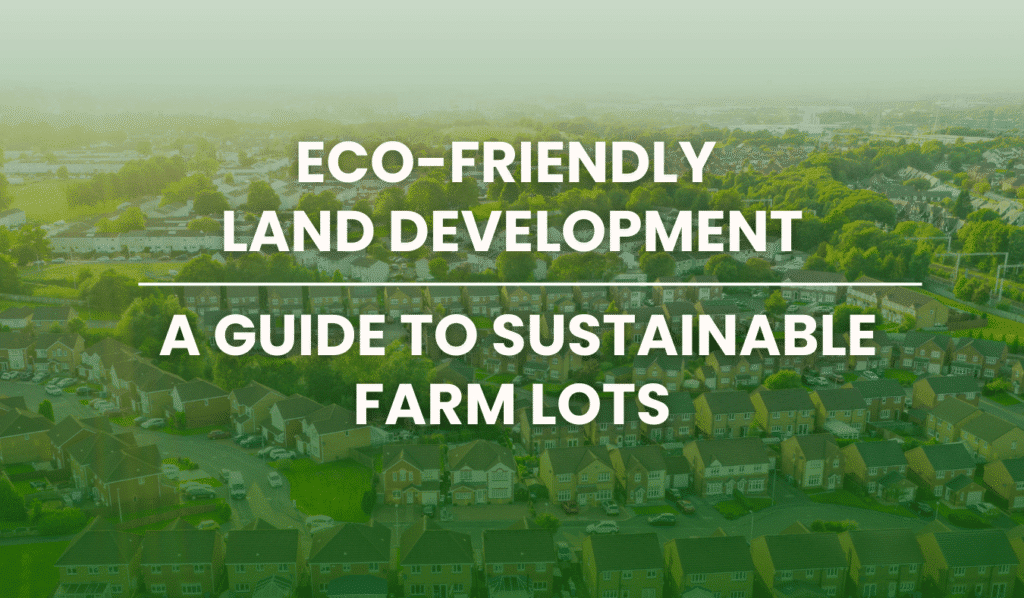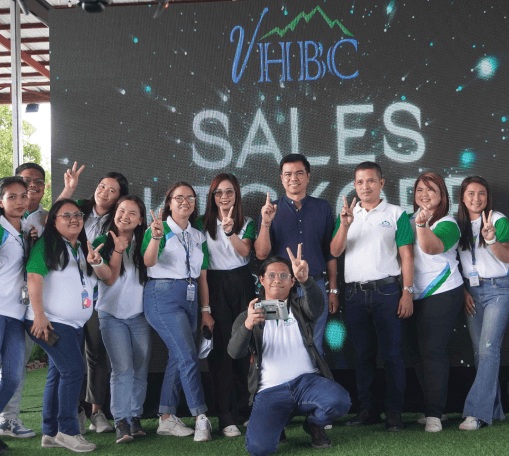Introduction to Sustainable Land Development for Farm Lots
Eco-Friendly Land Development is shaping the future of modern communities and redefining the way people live and invest. Developers are now creating farm lots with sustainability at the core, ensuring that both families and investors gain long-term benefits. These developments focus on renewable energy, water conservation, organic farming, and eco-conscious infrastructure to deliver healthier lifestyles and lasting value.
For families, this means access to green spaces, farm-to-table produce, and communities designed to promote well-being. For investors, Eco-Friendly Land Development ensures properties that not only appreciate in value but also align with the growing global demand for sustainable living.
By combining modern comforts with responsible land use, sustainable farm lot communities become more than just places to live—they become thriving environments where people and nature work together. Through eco-friendly amenities, smart design, and long-term planning, these developments pave the way for a brighter and greener future.
Why Sustainable Land Development Matters
The demand for sustainable land development for farm lots continues to rise because it directly affects quality of life. These developments conserve natural resources, reduce waste, and promote renewable energy. By adopting sustainable models, farm communities stay attractive for buyers who value green living.
If you’re exploring leisure farm living, VHBC Leisure Farms highlights how eco-friendly spaces contribute to community well-being. Proper planning ensures farm lots become both a sanctuary for families and a sound financial investment.
According to the United Nations Sustainable Development Goals, responsible land use supports global climate goals. Aligning local projects with these initiatives makes farm communities part of a bigger sustainability movement.
Eco-Friendly Amenities for Leisure Farm Communities
Eco-friendly amenities for leisure farm communities provide both comfort and sustainability. Developers include solar-powered streetlights, shared organic gardens, and walking paths shaded by native trees. These features improve well-being while lowering maintenance costs.
For instance, leisure farms often promote farm-to-table lifestyles by growing fresh produce on-site. Families enjoy healthier diets while reducing food expenses. A Philippine Department of Tourism initiative on agritourism also encourages eco-friendly farming as a way to attract visitors and create livelihood opportunities.
Internal roads lined with greenery, bike-friendly paths, and community centers powered by renewable energy all enhance property value. These amenities make eco-friendly communities attractive for both homeowners and investors.
Solar Power and Rainwater Harvesting for Farm Lots
The cost of Eco-Friendly Land Development may appear higher at first compared to traditional land development methods. However, when looking at long-term benefits such as utility savings, lower maintenance expenses, and increased resale value, the investment proves to be cost-effective. Families and investors quickly realize that sustainable development is not just about protecting the environment—it is also about securing financial advantages.
For example, solar panels cut monthly electricity costs by generating clean, renewable energy. Rainwater harvesting systems reduce water bills while promoting responsible resource use. Green building practices, such as using bamboo, recycled wood, and other durable materials, significantly reduce repair and maintenance costs over time. As a result, homeowners enjoy better living conditions while saving money each year.
From the perspective of developers, Eco-Friendly Land Development brings additional financial opportunities. Many governments, including the Philippines, now offer incentives and grants for sustainable projects. These supports can offset initial construction costs, making eco-friendly communities more practical and accessible for both developers and buyers.
Moreover, properties developed with sustainable features often appreciate in value faster. Today’s buyers actively seek homes and farm lots that match their environmental values. This growing demand ensures that early investments in sustainable projects provide strong returns in the future.
When considering the bigger picture, the cost of Eco-Friendly Land Development becomes an investment in long-term profitability, healthier living, and environmental preservation—making it the smarter choice for both families and investors.
Green Building Practices for Farm Lots
Green building practices for farm lots play a key role in advancing Eco-Friendly Land Development. These practices focus on eco-conscious design, resource efficiency, and healthier living environments for families. Builders often incorporate recycled or locally sourced materials, natural ventilation systems, and energy-saving appliances to minimize waste and reduce utility expenses.
Sustainable designs are created to maximize natural elements. For example, homes are positioned to capture sunlight during the day and take advantage of natural wind flow to reduce electricity usage. Simple yet effective features—such as installing larger windows for daylight, using reflective roofing materials, or planting shade trees around the property—significantly improve comfort while lowering long-term costs.
These methods not only save families money but also make farm lots more affordable and sustainable over time. When combined with renewable energy sources like solar power and rainwater harvesting systems, green building practices ensure that communities thrive without straining natural resources.
The World Green Building Council highlights that eco-friendly buildings cut carbon emissions and promote healthier lifestyles. Farm communities that adopt these standards stand out from conventional developments by offering residents more value, greater comfort, and stronger investment potential.
By embracing green building practices, developers and homeowners contribute to Eco-Friendly Land Development that benefits both people and the planet. It’s a forward-thinking approach that ensures farm communities remain sustainable, resilient, and attractive for future generations.
The Cost of Sustainable Land Development
The cost of sustainable land development can initially seem higher than traditional methods. However, when considering long-term utility savings, lower maintenance expenses, and increased resale value, the investment pays off.
For example, solar panels reduce monthly electricity costs significantly. Rainwater harvesting decreases water bills. Using durable and eco-friendly materials reduces repair costs over time. Families save money while enjoying a better lifestyle.
Developers can also benefit from government incentives and grants related to green projects. These financial supports offset some of the initial expenses, making sustainable farm development more accessible.
Why It Works for Investors and Families
Eco-Friendly Land Development works because it balances modern comfort with long-term sustainability. Families enjoy healthier living spaces surrounded by nature. Investors benefit from higher property values as demand for sustainable communities continues to rise.
Projects that feature renewable energy, organic gardens, and eco-friendly amenities create strong selling points. Today’s buyers actively search for properties that align with their environmental values and lifestyle choices.
By showcasing Eco-Friendly Land Development in marketing strategies, developers can attract both local and international buyers. Internal linking to content like Leisure Farm Community Benefits further highlights how sustainable practices add long-term lifestyle and investment value.
How to Rank Your Sustainable Farm Project
Ranking a sustainable farm project online requires a smart blend of SEO strategy, transparency, and consistent content creation. Developers must highlight the benefits of Eco-Friendly Land Development while building credibility with potential buyers and investors.
The first step is to optimize a website with relevant keywords such as sustainable land development for farm lots, eco-friendly amenities for leisure farm communities, and green building practices for farm lots. Using these terms naturally in titles, meta descriptions, and blog articles helps search engines recognize the project as a trusted source for sustainability-related searches.
Developers should also increase authority by linking to reputable external sources. Referencing organizations like the UN Sustainable Development Goals or the World Green Building Council demonstrates alignment with global sustainability efforts. These external references not only add credibility but also show buyers that the project supports recognized environmental standards.
Content marketing is another powerful way to boost rankings. Sharing client testimonials highlights trust and satisfaction. Publishing detailed case studies of solar panel installations, rainwater harvesting systems, or organic farming setups helps potential buyers visualize the benefits of eco-friendly living. Regular community updates and success stories also improve engagement and signal to search engines that the website is active and relevant.
Finally, internal linking strengthens SEO by guiding readers to related content. For example, a blog about Leisure Farm Community Benefits can connect to articles on renewable energy savings or green building practices. This improves user experience while keeping visitors engaged longer, which is a key factor in higher search rankings.
By combining keyword optimization, credible references, valuable content, and strong internal linking, developers can ensure their sustainable farm projects stand out online. In a market where demand for Eco-Friendly Land Development continues to grow, ranking higher means attracting more buyers and investors who are ready to embrace a greener lifestyle.
Conclusion
Eco-Friendly Land Development is not just a passing trend—it is a lifestyle shift that brings lasting benefits to families, investors, and the environment. By embracing sustainable land development for farm lots, communities are able to combine modern amenities with eco-conscious practices that ensure healthier living and stronger financial growth.
These communities offer solar power, rainwater harvesting, organic farming spaces, and green building practices that reduce costs while improving quality of life. Families enjoy fresh air, farm-to-table produce, and safe surroundings where children can grow close to nature. At the same time, investors benefit from the rising demand for sustainable properties, making eco-friendly developments a secure long-term investment.
What makes Eco-Friendly Land Development so effective is its ability to create balance. It provides the comforts of modern living without compromising natural resources. Developers also gain an advantage by marketing properties that reflect today’s environmental values, appealing to both local and global buyers who actively seek sustainable communities.
Ultimately, choosing Eco-Friendly Land Development for farm lots ensures that families experience healthier lifestyles, investors secure greater returns, and the environment is preserved for generations to come. By supporting sustainable projects today, we all contribute to building greener communities and a more resilient future.




























